 Published in 2020 by Windmill Books, an imprint of Rosen Publishing 29 East 21st Street, New York, NY 10010 Copyright 2020 Miles Kelly Publishing All rights reserved. No part of this book may be reproduced in any form without permission in writing from the publisher, except by a reviewer. Publishing Director: Belinda Gallagher Creative Director: Jo Cowan Senior Editor: Claire Philip Designers: Andrea Slane, Joe Jones Consultant: Rupert Matthews Indexer: Jane Parker Image Manager: Liberty Newton Production: Elizabeth Collins, Caroline Kelly Reprographics: Stephan Davis, Thom Allaway Assets: Lorraine King Cataloging-in-Publication Data Names: Adams, Simon. Title: Project Ancient Egypt / Simon Adams. Description: New York: Windmill Books, 2020. | Series: The project makers | Includes index.
Published in 2020 by Windmill Books, an imprint of Rosen Publishing 29 East 21st Street, New York, NY 10010 Copyright 2020 Miles Kelly Publishing All rights reserved. No part of this book may be reproduced in any form without permission in writing from the publisher, except by a reviewer. Publishing Director: Belinda Gallagher Creative Director: Jo Cowan Senior Editor: Claire Philip Designers: Andrea Slane, Joe Jones Consultant: Rupert Matthews Indexer: Jane Parker Image Manager: Liberty Newton Production: Elizabeth Collins, Caroline Kelly Reprographics: Stephan Davis, Thom Allaway Assets: Lorraine King Cataloging-in-Publication Data Names: Adams, Simon. Title: Project Ancient Egypt / Simon Adams. Description: New York: Windmill Books, 2020. | Series: The project makers | Includes index.
Identifiers: ISBN 9781538392201 (pbk.) | ISBN 9781725393011 (library bound) | ISBN 9781538392218 (6 pack) Subjects: LCSH: Egypt--Civilization--To 332 B.C.--Juvenile literature. | Handicraft--Juvenile literature. Classification: LCC DT61.A37 2019 | DDC 932.01--dc23 Manufactured in the United States of America CPSIA Compliance Information: Batch #BW20WM: For Further Information contact Rosen Publishing, New York, New York at 1-800-237-9932 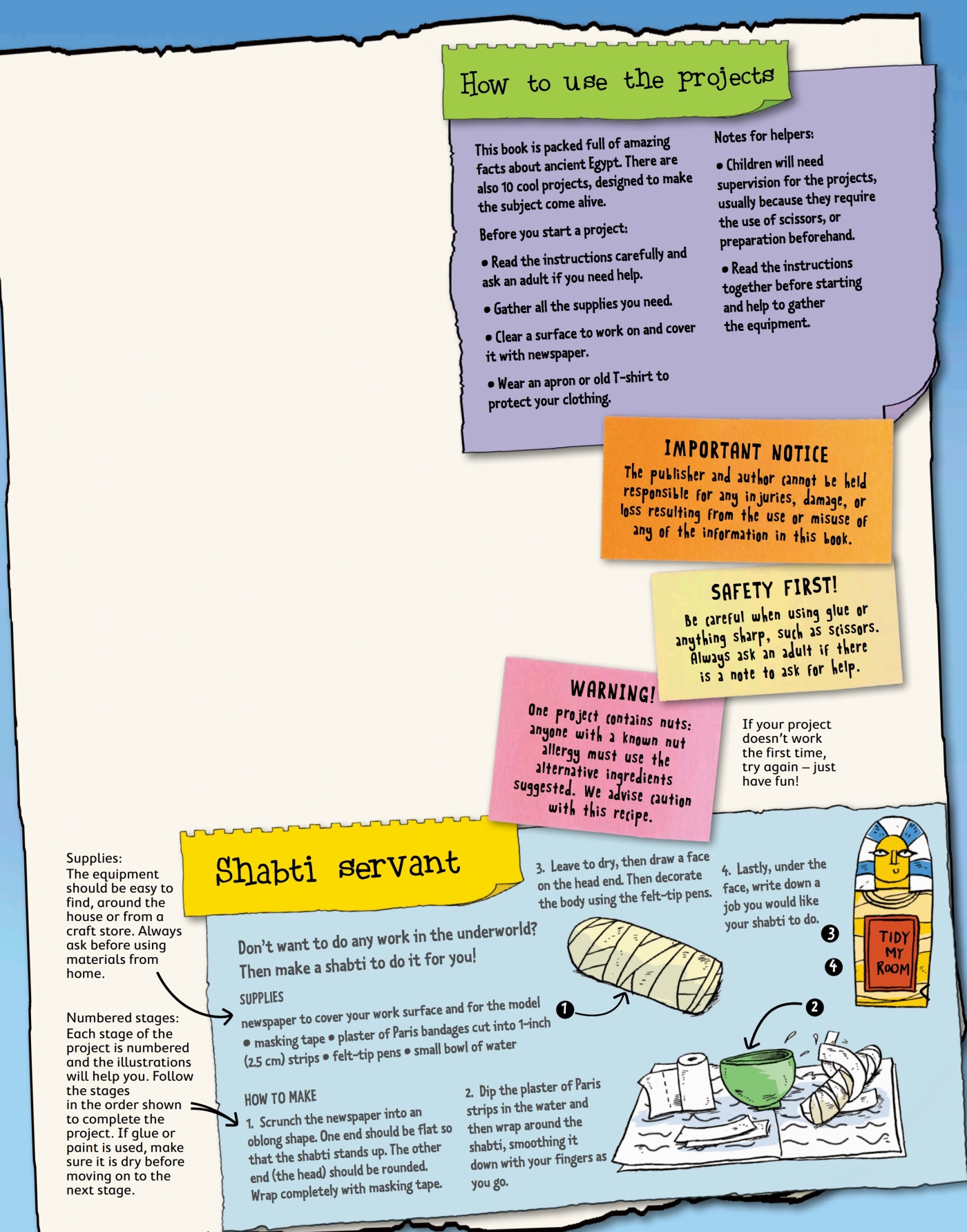 CONTENTS Float your boat A pharaoh's headdress Ankh amulet Pyramid model Play the sistrum Shabti servant Hieroglyphic challenge Egyptian sweets Papyrus paper WEAR A WESEKH!
CONTENTS Float your boat A pharaoh's headdress Ankh amulet Pyramid model Play the sistrum Shabti servant Hieroglyphic challenge Egyptian sweets Papyrus paper WEAR A WESEKH!  LIFE-GIVING RIVER Around 5,000 years ago, an incredible civilization grew up along the banks of the Nile River in Egypt. The ancient Egyptians were very advanced for their time, building vast towns, beautiful temples, and an impressive empire.
LIFE-GIVING RIVER Around 5,000 years ago, an incredible civilization grew up along the banks of the Nile River in Egypt. The ancient Egyptians were very advanced for their time, building vast towns, beautiful temples, and an impressive empire. 
 ALMIGHTY RULERS Intro textA long line of kings and some queens known as pharaohs ruled ancient Egypt. The pharaoh was the most important person in the land.
ALMIGHTY RULERS Intro textA long line of kings and some queens known as pharaohs ruled ancient Egypt. The pharaoh was the most important person in the land.
His role was to hand out justice, ensure law and order, and protect Egypt from foreign invaders. 
 LAND OF THE GODS Hundreds of different gods were worshipped in ancient Egypt. Some had specific roles, such as helping the crops to grow or the Nile to flood. Gods could be both cruel and kind, and went in and out of fashion. Over the years the names, roles, and appearances of some gods changed.
LAND OF THE GODS Hundreds of different gods were worshipped in ancient Egypt. Some had specific roles, such as helping the crops to grow or the Nile to flood. Gods could be both cruel and kind, and went in and out of fashion. Over the years the names, roles, and appearances of some gods changed. 
 PYRAMID POWER! When a pharaoh died, he was buried in a pyramid-shaped tomb.
PYRAMID POWER! When a pharaoh died, he was buried in a pyramid-shaped tomb.
The first pyramid had stepped sides, and was built for King Djoser around 2630 BC. Later pyramids had sloped sides. Some people believe the tombs represented a stairway to heaven. 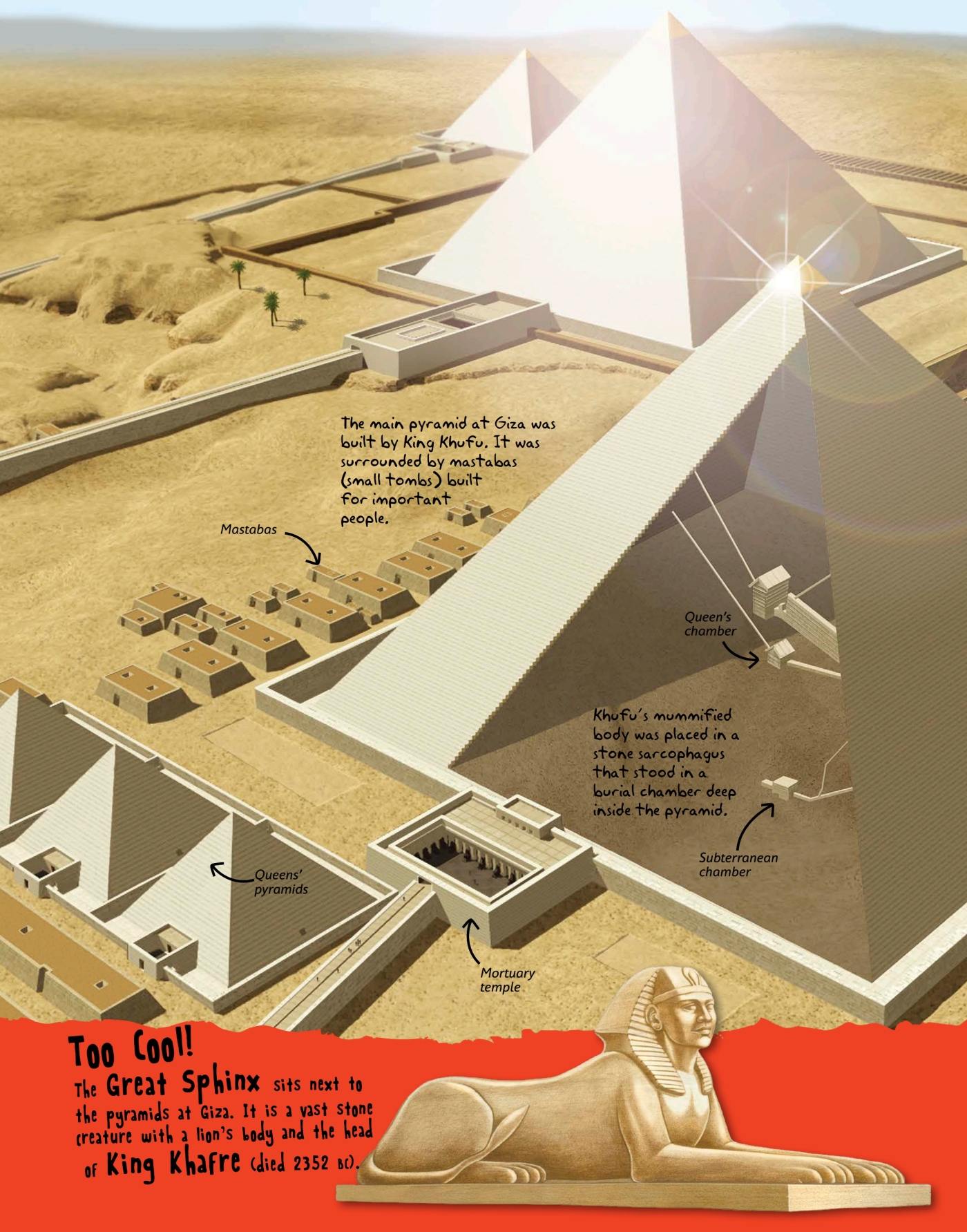
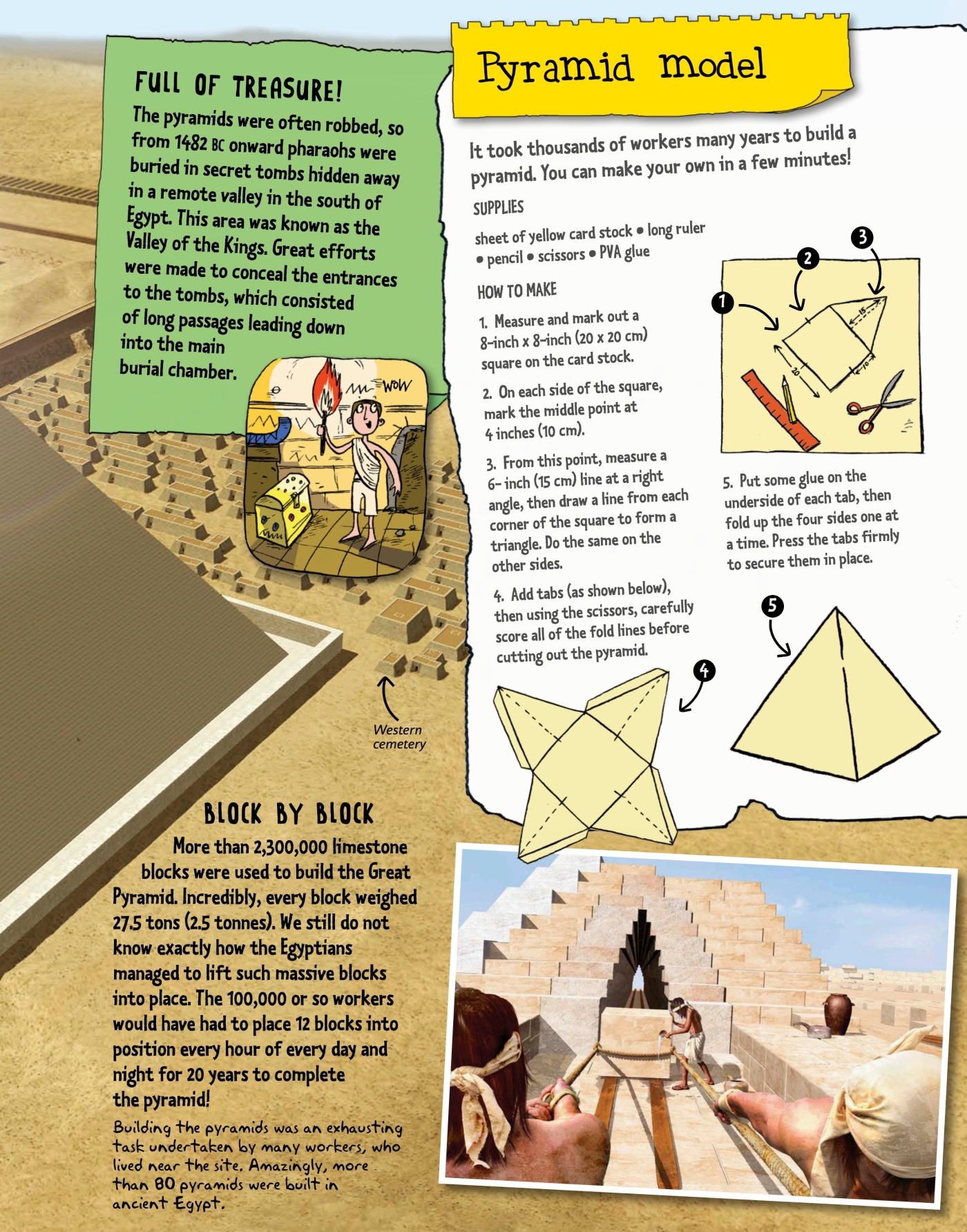 MAGNIFICENT TEMPLES The Egyptians built grand stone temples for their many gods to live in. They believed that the gods spirit lived in a statue, which was housed in a small inner sanctuary.
MAGNIFICENT TEMPLES The Egyptians built grand stone temples for their many gods to live in. They believed that the gods spirit lived in a statue, which was housed in a small inner sanctuary. 
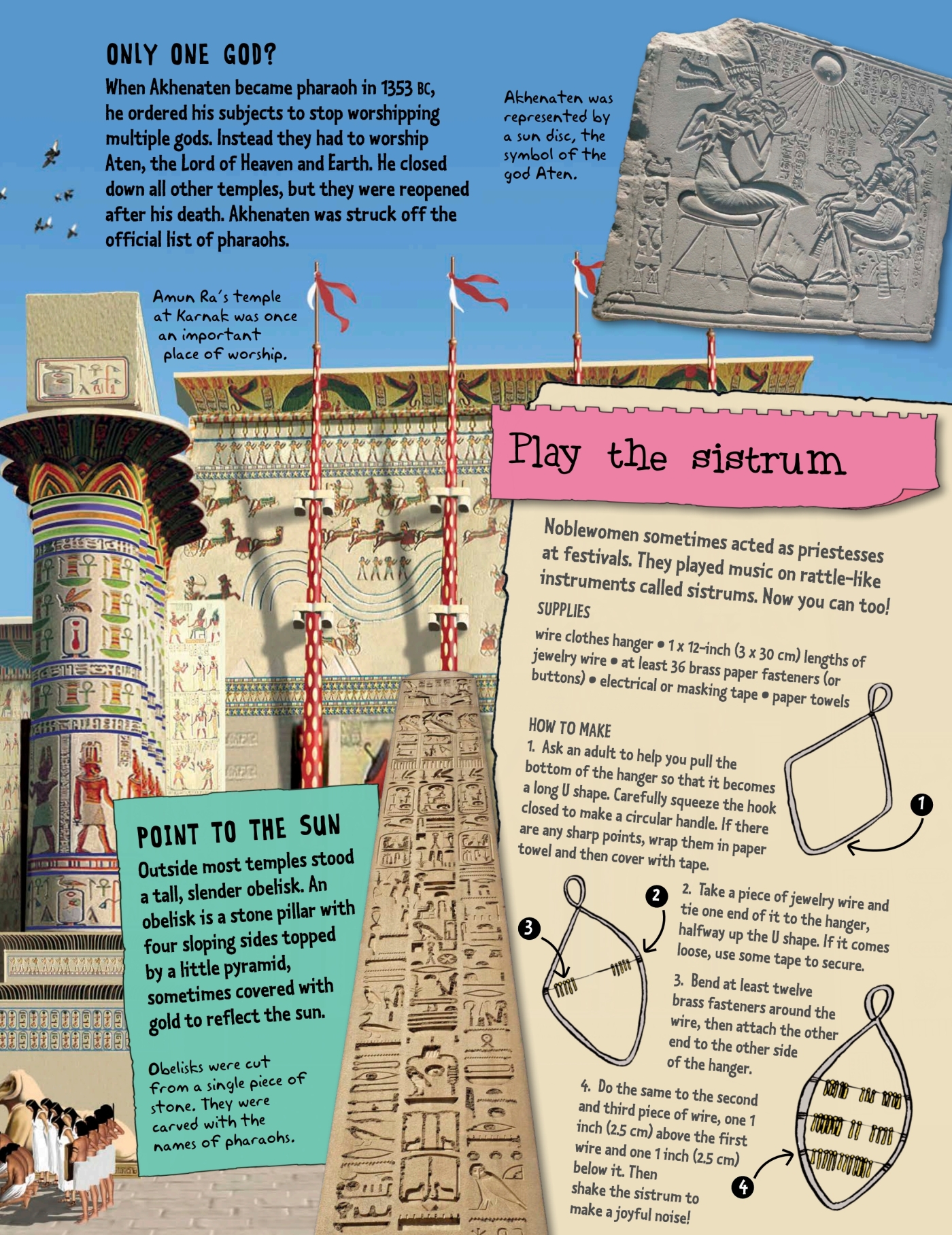 BURYING THE DEAD When they died, the pharaohs were buried in style! Once they were mummified (see inside), their bodies were placed inside a series of coffins, each f itting snugly inside another.
BURYING THE DEAD When they died, the pharaohs were buried in style! Once they were mummified (see inside), their bodies were placed inside a series of coffins, each f itting snugly inside another. 
 BURYING THE DEAD When they died, the pharaohs were buried in style! Once they were mummified (see inside), their bodies were placed inside a series of coffins, each f itting snugly inside another.
BURYING THE DEAD When they died, the pharaohs were buried in style! Once they were mummified (see inside), their bodies were placed inside a series of coffins, each f itting snugly inside another.
This set was then placed inside a large outer coffin known as a sarcophagus. 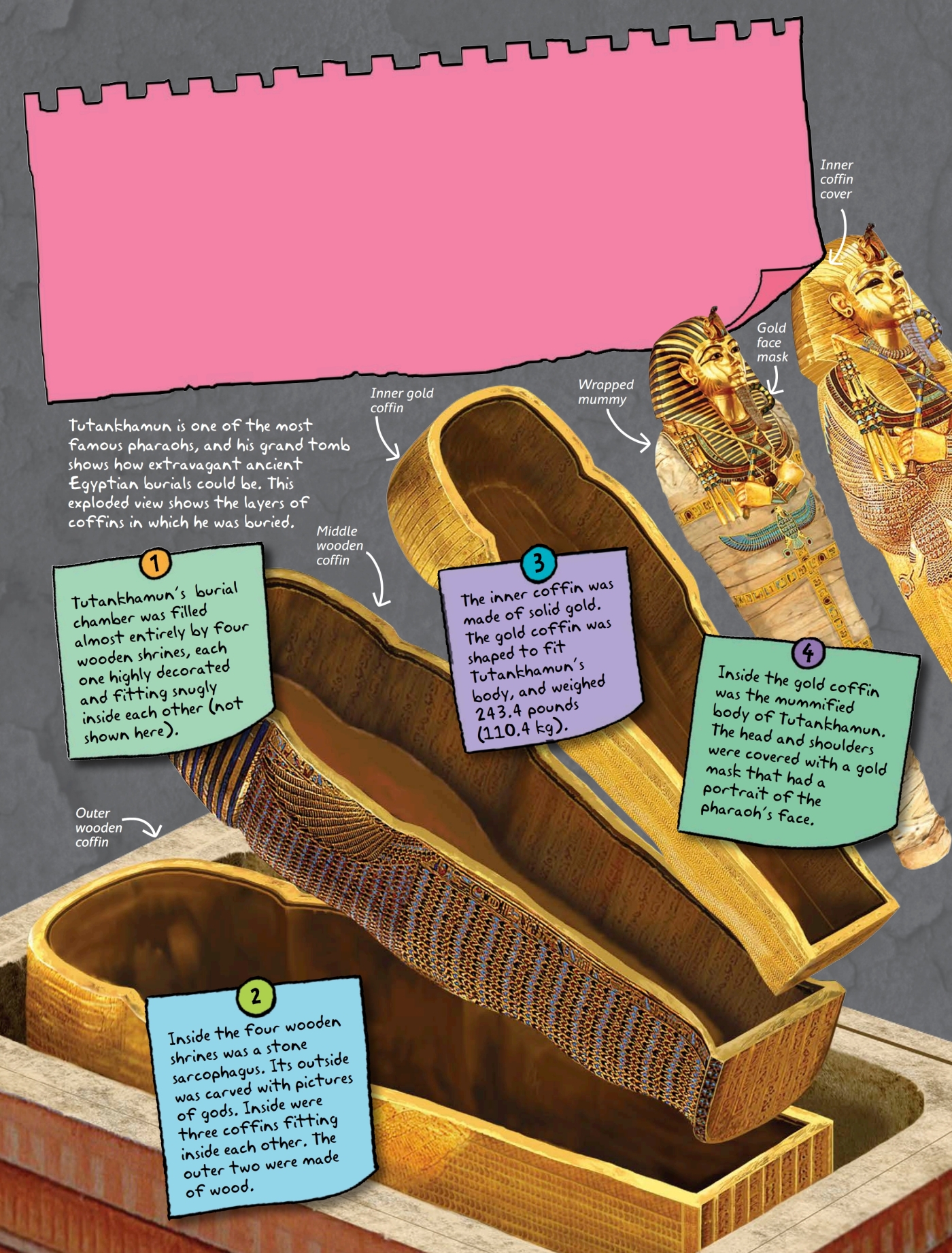
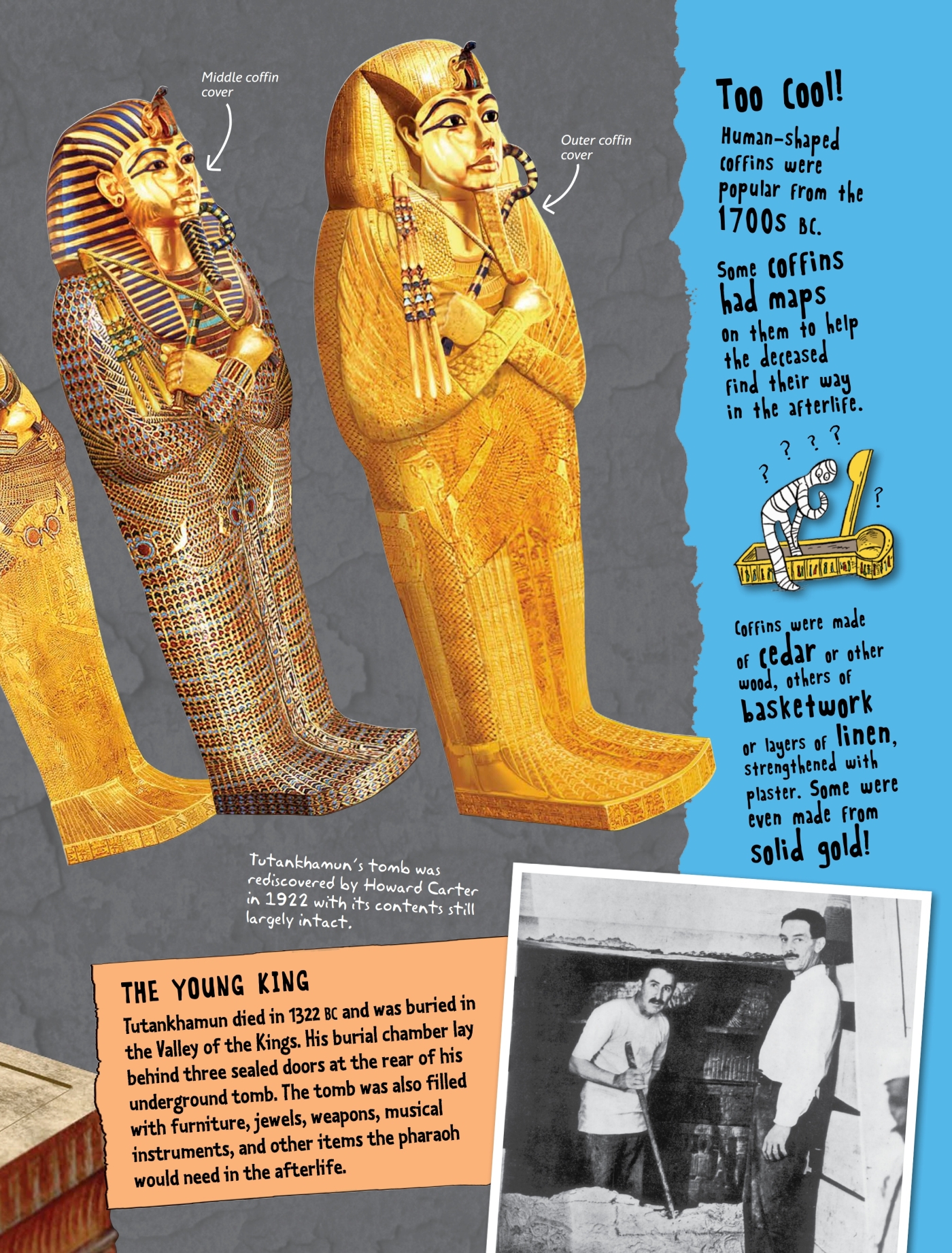 PRESERVING THE DEAD The ancient Egyptians believed that dead people needed their bodies in the afterlife, so they went to great lengths to preserve them. This elaborate process was known as mummification and it took weeks to achieve. Once it was complete, the body was preserved forever.
PRESERVING THE DEAD The ancient Egyptians believed that dead people needed their bodies in the afterlife, so they went to great lengths to preserve them. This elaborate process was known as mummification and it took weeks to achieve. Once it was complete, the body was preserved forever. 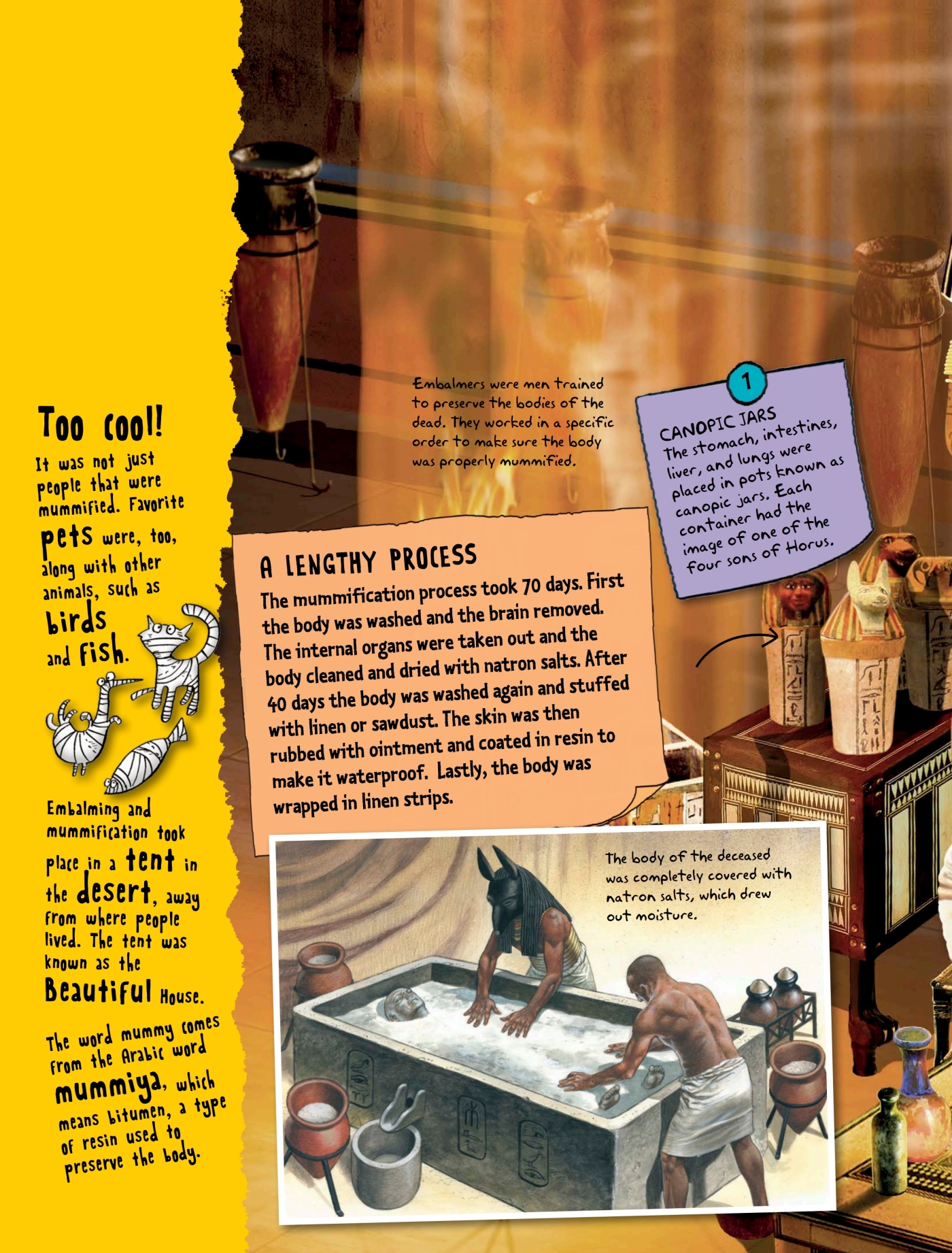


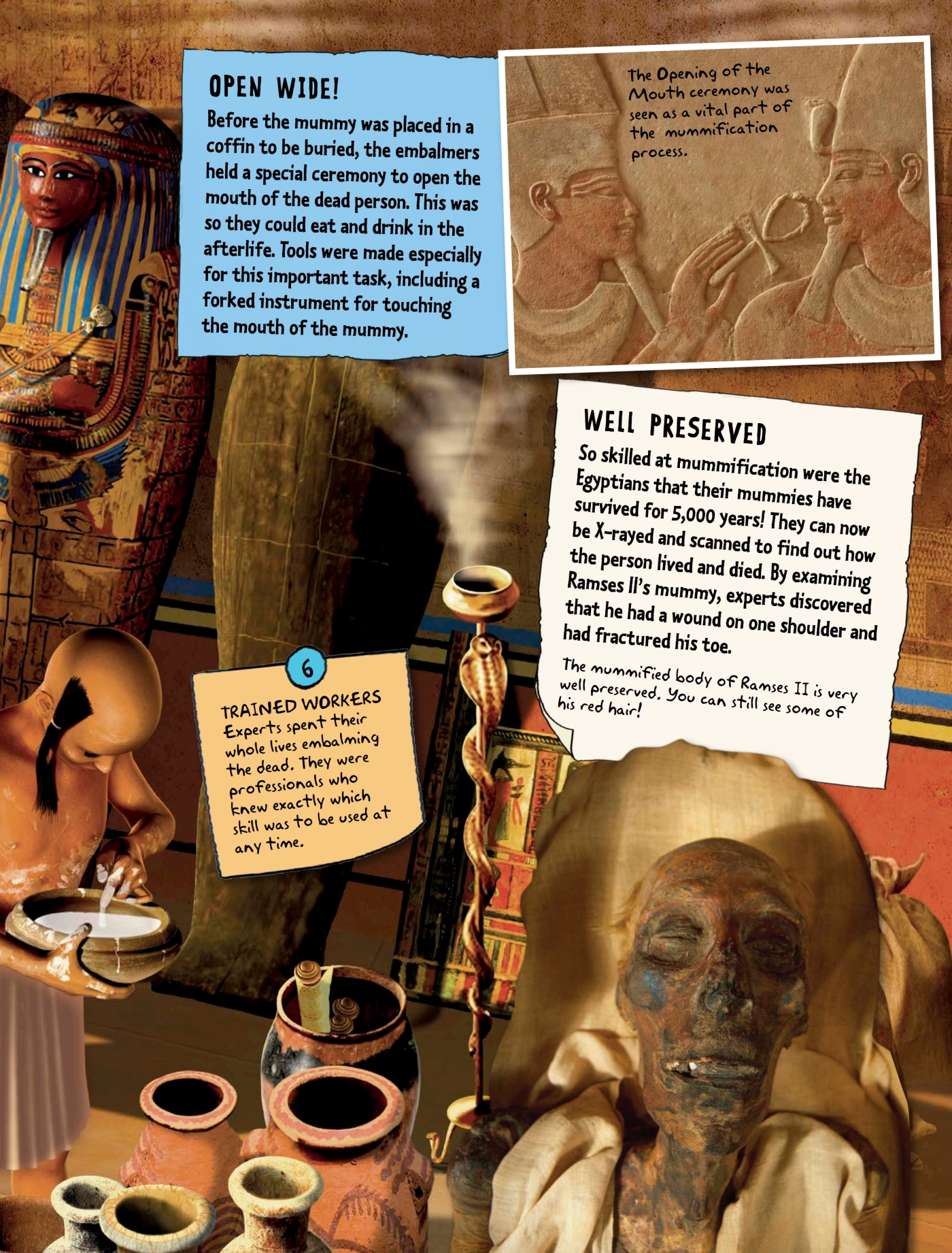 LIFE AFTER DEATH Egyptians believed that when they died, their soul would travel to the underworld. They called this world Duat, and it was a place of many terrors to be overcome.
LIFE AFTER DEATH Egyptians believed that when they died, their soul would travel to the underworld. They called this world Duat, and it was a place of many terrors to be overcome.
If the soul survived, it would enter a heavenly afterlife ruled over by the god Osiris. 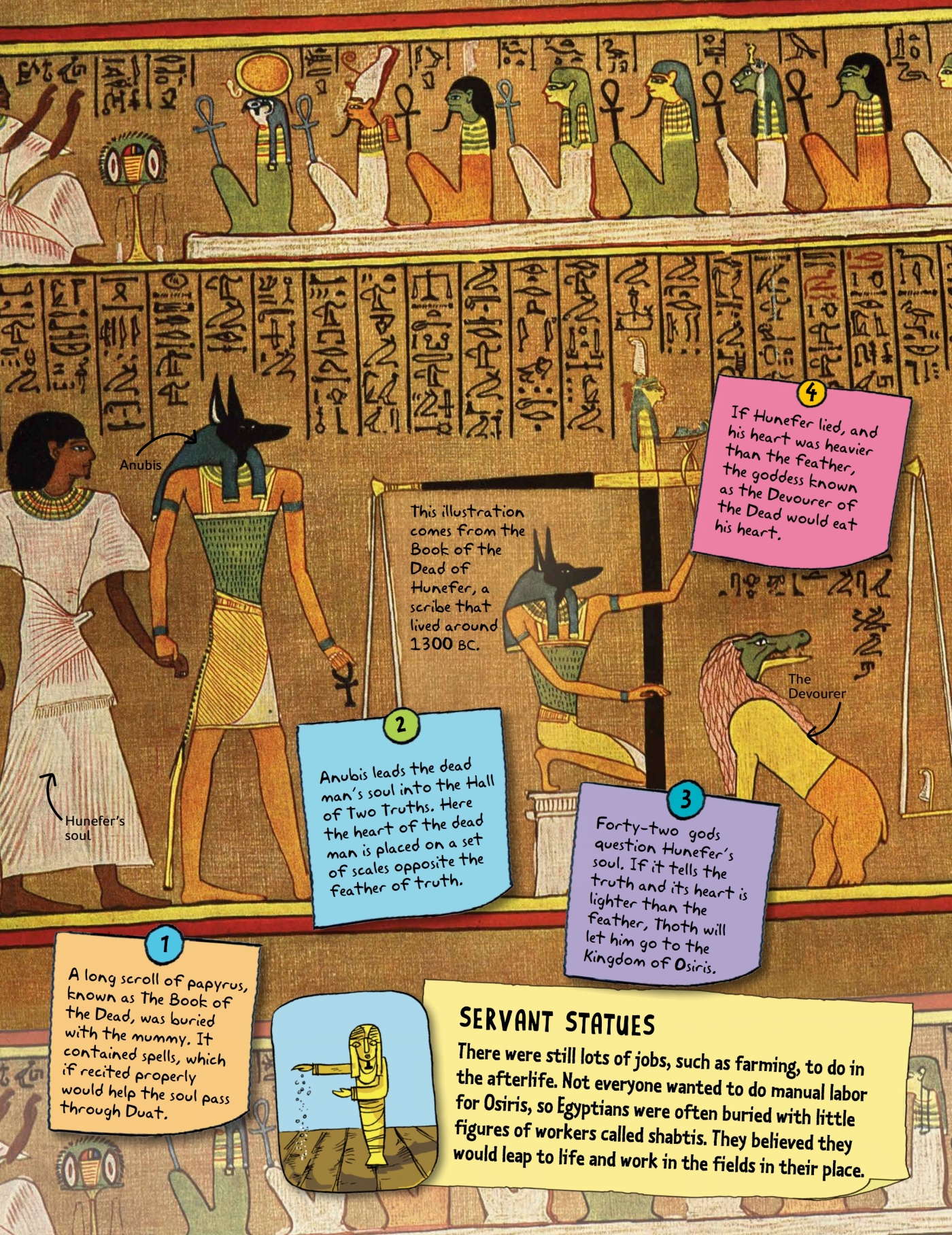
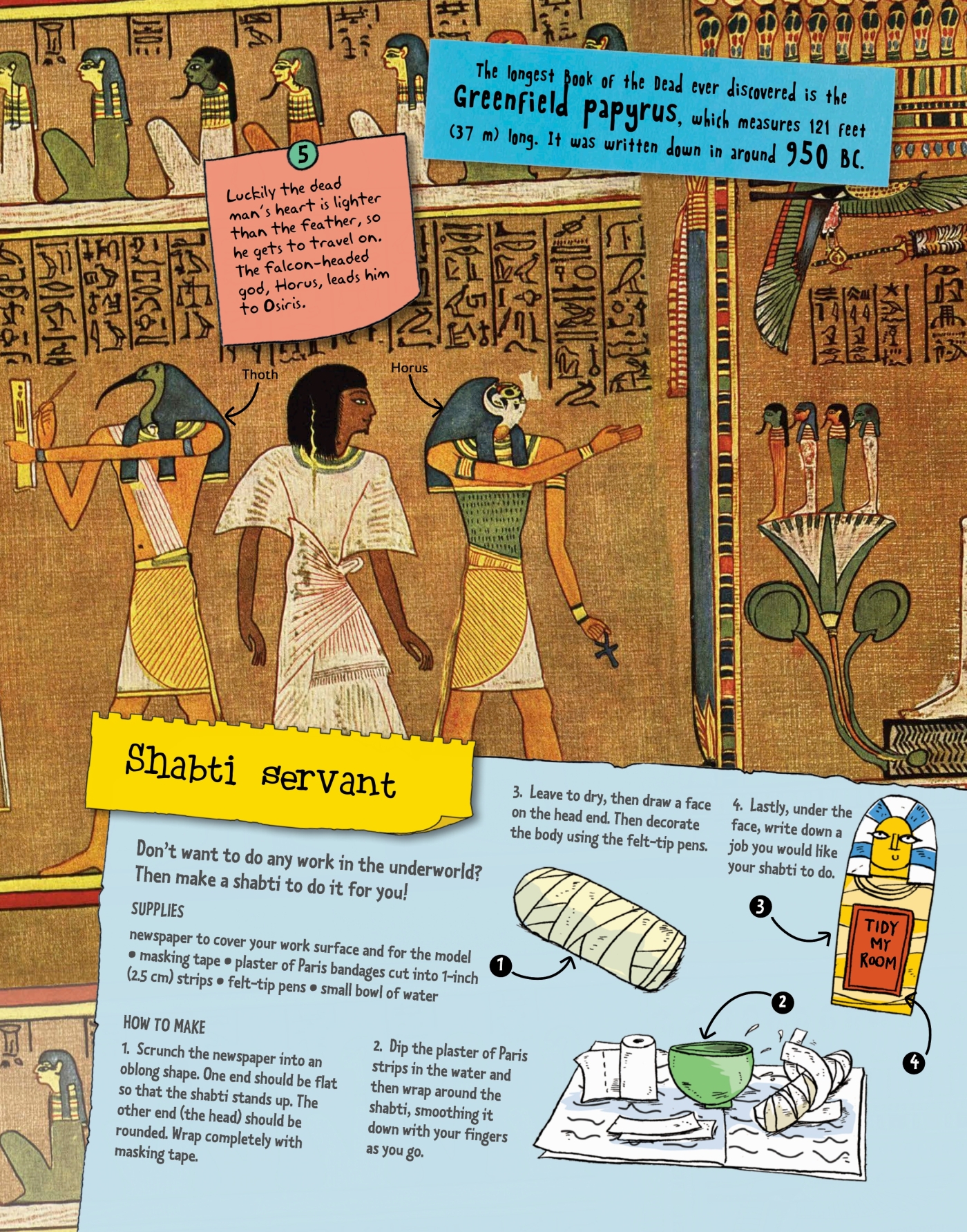 WRITING IT DOWN The Egyptian alphabet was made up of around 700 pictures called hieroglyphs. Each picture represented a sound, object or idea. This complicated system was developed in around 3100 BC, and is one of the oldest written languages in the world.
WRITING IT DOWN The Egyptian alphabet was made up of around 700 pictures called hieroglyphs. Each picture represented a sound, object or idea. This complicated system was developed in around 3100 BC, and is one of the oldest written languages in the world. 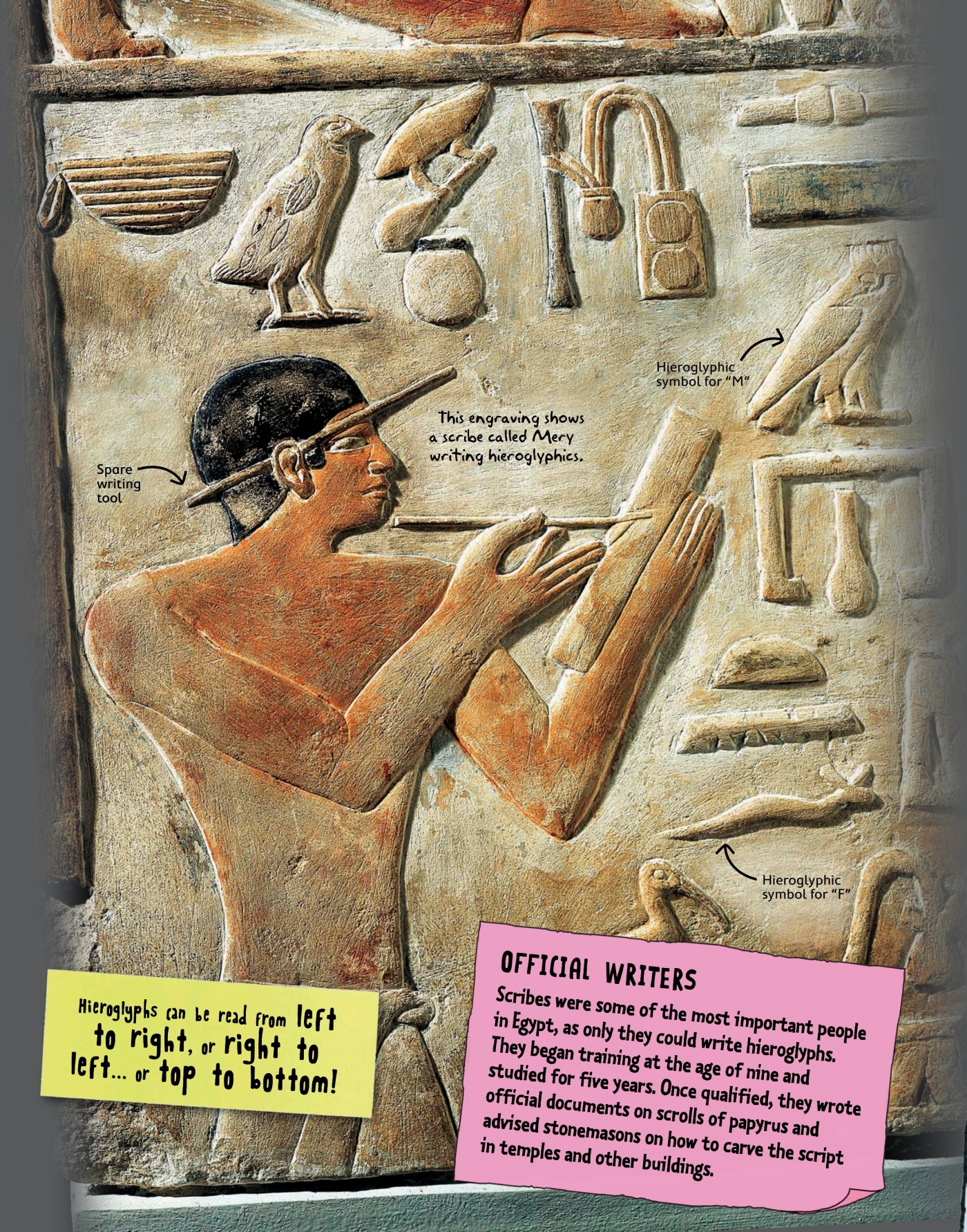
Next page


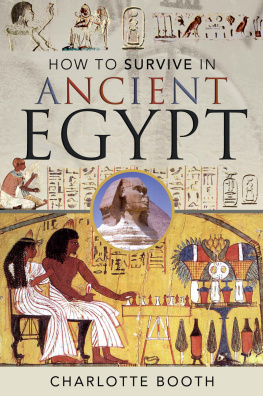

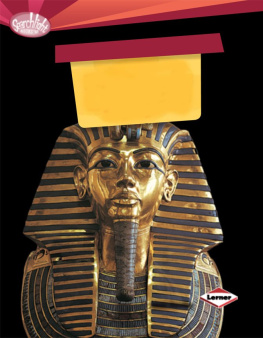

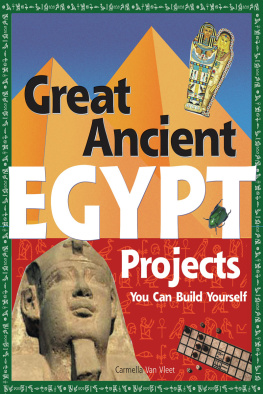
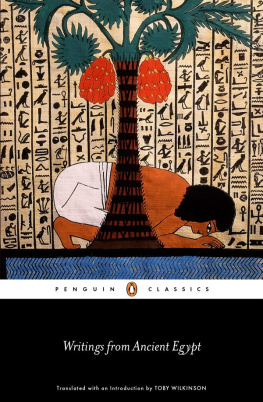
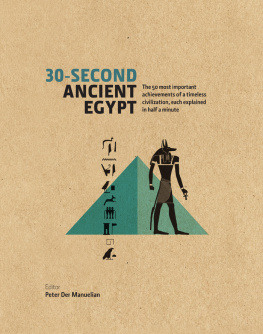
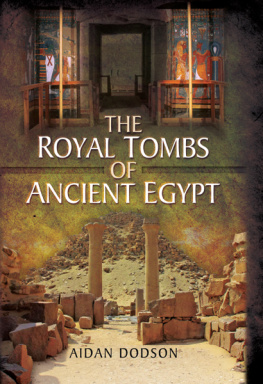
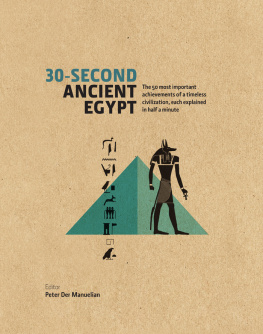
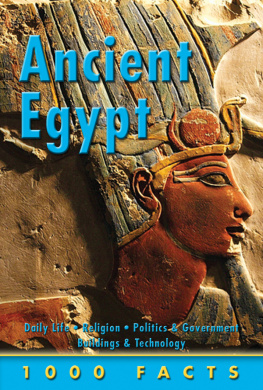
 Published in 2020 by Windmill Books, an imprint of Rosen Publishing 29 East 21st Street, New York, NY 10010 Copyright 2020 Miles Kelly Publishing All rights reserved. No part of this book may be reproduced in any form without permission in writing from the publisher, except by a reviewer. Publishing Director: Belinda Gallagher Creative Director: Jo Cowan Senior Editor: Claire Philip Designers: Andrea Slane, Joe Jones Consultant: Rupert Matthews Indexer: Jane Parker Image Manager: Liberty Newton Production: Elizabeth Collins, Caroline Kelly Reprographics: Stephan Davis, Thom Allaway Assets: Lorraine King Cataloging-in-Publication Data Names: Adams, Simon. Title: Project Ancient Egypt / Simon Adams. Description: New York: Windmill Books, 2020. | Series: The project makers | Includes index.
Published in 2020 by Windmill Books, an imprint of Rosen Publishing 29 East 21st Street, New York, NY 10010 Copyright 2020 Miles Kelly Publishing All rights reserved. No part of this book may be reproduced in any form without permission in writing from the publisher, except by a reviewer. Publishing Director: Belinda Gallagher Creative Director: Jo Cowan Senior Editor: Claire Philip Designers: Andrea Slane, Joe Jones Consultant: Rupert Matthews Indexer: Jane Parker Image Manager: Liberty Newton Production: Elizabeth Collins, Caroline Kelly Reprographics: Stephan Davis, Thom Allaway Assets: Lorraine King Cataloging-in-Publication Data Names: Adams, Simon. Title: Project Ancient Egypt / Simon Adams. Description: New York: Windmill Books, 2020. | Series: The project makers | Includes index. CONTENTS Float your boat A pharaoh's headdress Ankh amulet Pyramid model Play the sistrum Shabti servant Hieroglyphic challenge Egyptian sweets Papyrus paper WEAR A WESEKH!
CONTENTS Float your boat A pharaoh's headdress Ankh amulet Pyramid model Play the sistrum Shabti servant Hieroglyphic challenge Egyptian sweets Papyrus paper WEAR A WESEKH!  LIFE-GIVING RIVER Around 5,000 years ago, an incredible civilization grew up along the banks of the Nile River in Egypt. The ancient Egyptians were very advanced for their time, building vast towns, beautiful temples, and an impressive empire.
LIFE-GIVING RIVER Around 5,000 years ago, an incredible civilization grew up along the banks of the Nile River in Egypt. The ancient Egyptians were very advanced for their time, building vast towns, beautiful temples, and an impressive empire. 
 ALMIGHTY RULERS Intro textA long line of kings and some queens known as pharaohs ruled ancient Egypt. The pharaoh was the most important person in the land.
ALMIGHTY RULERS Intro textA long line of kings and some queens known as pharaohs ruled ancient Egypt. The pharaoh was the most important person in the land.
 LAND OF THE GODS Hundreds of different gods were worshipped in ancient Egypt. Some had specific roles, such as helping the crops to grow or the Nile to flood. Gods could be both cruel and kind, and went in and out of fashion. Over the years the names, roles, and appearances of some gods changed.
LAND OF THE GODS Hundreds of different gods were worshipped in ancient Egypt. Some had specific roles, such as helping the crops to grow or the Nile to flood. Gods could be both cruel and kind, and went in and out of fashion. Over the years the names, roles, and appearances of some gods changed. 
 PYRAMID POWER! When a pharaoh died, he was buried in a pyramid-shaped tomb.
PYRAMID POWER! When a pharaoh died, he was buried in a pyramid-shaped tomb.
 MAGNIFICENT TEMPLES The Egyptians built grand stone temples for their many gods to live in. They believed that the gods spirit lived in a statue, which was housed in a small inner sanctuary.
MAGNIFICENT TEMPLES The Egyptians built grand stone temples for their many gods to live in. They believed that the gods spirit lived in a statue, which was housed in a small inner sanctuary. 
 BURYING THE DEAD When they died, the pharaohs were buried in style! Once they were mummified (see inside), their bodies were placed inside a series of coffins, each f itting snugly inside another.
BURYING THE DEAD When they died, the pharaohs were buried in style! Once they were mummified (see inside), their bodies were placed inside a series of coffins, each f itting snugly inside another. 
 PRESERVING THE DEAD The ancient Egyptians believed that dead people needed their bodies in the afterlife, so they went to great lengths to preserve them. This elaborate process was known as mummification and it took weeks to achieve. Once it was complete, the body was preserved forever.
PRESERVING THE DEAD The ancient Egyptians believed that dead people needed their bodies in the afterlife, so they went to great lengths to preserve them. This elaborate process was known as mummification and it took weeks to achieve. Once it was complete, the body was preserved forever. 


 LIFE AFTER DEATH Egyptians believed that when they died, their soul would travel to the underworld. They called this world Duat, and it was a place of many terrors to be overcome.
LIFE AFTER DEATH Egyptians believed that when they died, their soul would travel to the underworld. They called this world Duat, and it was a place of many terrors to be overcome.
 WRITING IT DOWN The Egyptian alphabet was made up of around 700 pictures called hieroglyphs. Each picture represented a sound, object or idea. This complicated system was developed in around 3100 BC, and is one of the oldest written languages in the world.
WRITING IT DOWN The Egyptian alphabet was made up of around 700 pictures called hieroglyphs. Each picture represented a sound, object or idea. This complicated system was developed in around 3100 BC, and is one of the oldest written languages in the world. 